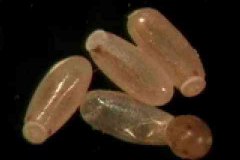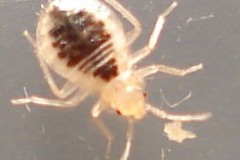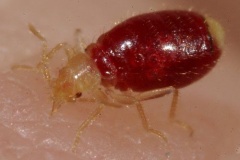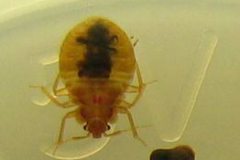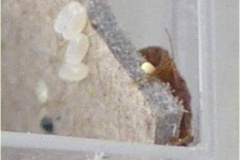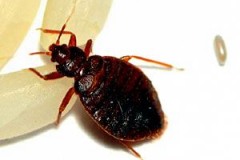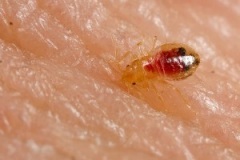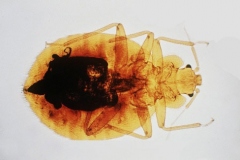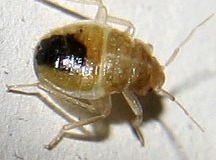Background
Bedbugs are known as ectoparasites, a group of insects that live outside on the bodies of humans, rats, guinea pigs, rabbits, bats, poultry, birds, and other warm-blooded animals. During the day, they hide in cracks and crevices of bed frames and headboards, behind wallpaper and wood work, inside mattresses and box springs, and even inside pictures. At night, they come out to feed, gorging themselves on blood.
Bedbugs are easily transported by people from one place to another on clothing and used furniture and through walls in apartment buildings and hotels. Bedbugs can also be transmitted to humans from bird and bat nests that may be present in homes.
Adult bedbugs are light tan to reddish brown in color with oval-shaped, wingless bodies. Their upper bodies are wrinkly and covered with short, blond hairs. Prior to feeding, they are 1/4 to 3/8 long (about the size of a pencil eraser) and almost as flat as a piece of paper. After feeding, they become bloated and dark red in color.
Young bedbugs are nearly colorless but look like smaller adults.
The eggs of bedbugs are white, pear-shaped, and about the size of a pin head with a lid at one end where the young will emerge. Clusters of 10 to 50 eggs each are laid in crevices. They usually hatch in about 10 days. Bedbugs take about 21 days to mature from egg to adult.
Bedbugs thrive in numbers so you may find adults, young, and eggs all in the same location.
Fortunately, bedbugs do not spread disease. Most people dont notice anything until they wake up the next morning with red, itchy spots on their face, neck, arms, and hands. Welts occurring in rows of three or more bites are telltale signs of bedbug feeding. These spots develop into welts that can persist for several days. The greatest risk to your health would be a mild skin infection caused by scratching the bites. You should consult your doctor who may recommend applying antibiotic ointments to the bites and taking an oral antihistamine to reduce itching and swelling. The nighttime feedings may also cause stress and sleeplessness.
Since theycan live for about six months without food, they may be present in abandoned buildingsor vacant apartments and homes.
Evidence of bedbugs can be found by their physical presence and what they leave behind. In the early stages of infestation, adults and young may be seen on the seams and tufts of mattresses. As the population grows, they move to cracks and crevices in headboards and bed frames, behind wallpaper and woodwork, in drapes, and among cushions of furniture. Bedbugs also leave behind drops of blood-colored excrement on mattresses, pillows, and sheets. In some cases, a distinctive, sweet odor is present.
If you think you have bedbugs, the first thing to do is get them properly identified.The West Virginia University Pest Identification Lab can do this free of charge.To have the suspect insect identified, place it in a sealable bag and take it toyour WVU Extension Service county office. That office will then send it to the labfor official identification.
Eradication of bedbugs requires a multistep approach known as Integrated Pest Management that includes thorough cleaning, applying pesticides, and preventing reinfestation. It may take up to two weeks to completely remove bedbugs so diligence is a key to success. However, the best treatment remains prevention.
First, get rid of clutter in your home, especially in your bedroom. Pick up discarded clothing, take down pictures and posters, throw out piles of magazines and newspapers, and remove throw- rugs. Next, vacuum everything every day until they are gone. Be sure to vacuum the mattress and box spring (especially around seams and tufts), headboards and bed frame, along baseboards, the entire carpet, draperies, and other wooden and fabric furniture in the room. If you have a bagless vacuum, empty the container immediately into a sealed plastic bag. If your vacuum has a bag, you can remove it and seal it in a plastic bag. The bags can then be placed in a freezer for 24 hours to kill the bedbugs. Next, clean your bed linens by placing them in a hot dryer (140 degrees F) for 20 minutes, or by placing them in a black plastic bag and putting them in a sealed car or unventilated green house for 24 hours, or by using a steam cleaner, or putting them out in the cold (32 degrees F or under) for 24 hours if it is winter. Then wash your linens in hot water with an enzyme cleaner or borax. In severe infestations, all bedding (linens, pillow, mattress and box spring) may need to be discarded.
Following cleaning, you can isolate your bed from remaining bedbugs by moving it away from the wall, sealing your mattress in a cover designed for dust mite control, preventing bedspreads and bed-skirts from touching the floor, or wrapping double-sided sticky tape around the legs of your bed. Since bedbugs cannot jump or fly, crawling is the only way they can get into the bed.
Professional pest services are also using a technique in which they superheat a room to above 100 degrees for several days to kill bedbugs.
Many pesticides that are less toxic and more effective than previously used chemicals are now available to control bedbugs. Silica gel dusts and pyrethrin dusts are often used in inaccessible places and behind walls. Residual sprays containing carbaryl, allethrin, cyfluthrin, deltamethrin, permethrin, pyrethrin, resmethrin, sumithrin, tetramethrin, and tralomethrin may be used indoors. They should be applied only to areas recommended on the product label. However, some products can be applied only by professional exterminators. Other insecticides and even household cleaning products contain botanical oils that kill the insects.
A new product on the market labeled for bedbug control, K-4 Products EcoBugFree (containing lauryl sulfate, sodium chloride, potassium chloride and other natural products), is being applied in hotels and shelters with success. It is available in many hardware stores and pharmacies for use by anyone.
When using pesticides, follow label directions and wear proper protective equipment. Contact your WVU Extension Service county office for more information about these and other pesticides labeled for controlling bedbugs.
If you are unable to eradicate bedbugs yourself, professional exterminating companies can be hired to take care of the problem.
After thorough cleaning and pesticide application, cracks and crevices in woodwork, along the bed frame and headboard, around windows and doors, and at electrical conduit openings should be sealed with a silicone caulk to reduce hiding places. Repair or remove peeling wallpaper, repair plaster cracks, and tighten switch plate and outlet covers. Avoid hanging too many pictures on the walls and placing too many pieces of furniture in rooms. Prevent clutter. Avoid buying or acquiring free furniture and bedding that may harbor bedbugs.
Bedbugs can breed year-round inside buildings. In West Virginia, they have two or three generations of young per year. They live about 10 to 12 months, and females can lay 100 to 500 eggs during their lifetime, depending on the warmth of the area and how much food it provides. Bedbugs can survive only at temperatures between 48 F and 97 F.
References:
Baniecki, J.F. et al. New least toxic bedbug product on the market. Look Whats Out There in Integrated Pest Management, Issue 11, Dec. 2006, West Virginia University Extension Service.
Gangloff-Kaufman, J. and J. Shultz, 2003. Bedbugs are back! An IPM answer. Cornell Cooperative Extension.
Jones, S.C. Bedbugs. Fact Sheet, HYG-2105-04. The Ohio State University.
Kells, S.A. and J. Hahn. 2006. Prevention and control of bedbugs in residences: information for home owners and tenants. University of Minnesota Extension Service.
Knodel, J. Bedbugs. North Dakota State University. http://www.ag.ndsu.nodak.edu/aginfo/entomology/entupdates/Indoor_pest/bed_bug.htm.
Potter, M.F. 2008. Bedbugs. ENTFACT 636. University of Kentucky Cooperative Extension Service.
See the rest here:
Bed Bugs | Extension Service | West Virginia University

 Residence
Residence  Location
Location 

